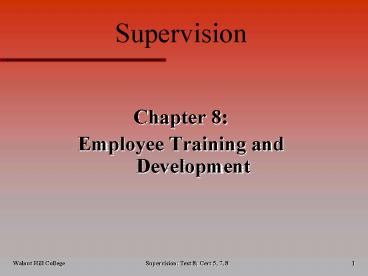Supervision - PowerPoint PPT Presentation
1 / 16
Title:
Supervision
Description:
Training: teaching people how to do their jobs. Three types ... Unreal expectations. Deal with people as they are...no assumptions, KISS. Poor Training Program ... – PowerPoint PPT presentation
Number of Views:288
Avg rating:3.0/5.0
Title: Supervision
1
Supervision
- Chapter 8
- Employee Training and Development
2
What Youll Learn
- Why train
- Who should perform training
- How employees learn
- Developing a job training program
- On the job training (job instruction
training) - Overcoming learning obstacles
3
Importance of Training
- Training teaching people how to do their jobs.
- Three types of training
- Orientation
- Initial introduction to the company
- Focus on norms and policies
- Job instruction
- What to do, and how to do it
- Retraining
- Improve performance
- Teach something new
Why Train???
4
Benefits of Training
- Training benefits
- Supervisor
- Standardize performance, more time to manage,
less absenteeism/turnover, reduced tensions,
consistency, lower costs, better service, more
customers - Workers
- Confidence, reduces stress, boosts morale,
increases job satisfaction, reduces accidents and
injuries, opportunity to advance - The Business
- Improves image, builds revenue and profits
5
Why NOT Train???
- Training is often neglected
- Urgency of need need them to be productivenow!
- Training time
- Costs
- Employee turnover
- Short-term workers
- Diversity of worker
- Span of jobs (simple to complex)
- Unsure of what to train
6
Quick Question
- A benefit of training is
- Giving the supervisor more time to manage
- Giving workers positive discipline
- Giving the business several warm bodies to do
work - Developing a buddy system
Answer A
7
The Training Performance
- Assigning the training
- Trailing, magic apron, buddy limit learning and
control - Training responsibility
- Supervisor is responsible for training
- Do it themselves
- Delegate training ensuring
- Proper person
- Proper training
- Proper tools
- Proper compensation
- Desire to train
- Follow up
Training the Trainer
8
Learning
- Learning is the acquisition of knowledge, skills,
or attitudes - Learning Styles people learn differently
- Reading, Hearing, Seeing, Doing, Multiple
- Employees learn best
- When they are actively involved in the learning
process - When training is relevant and practical
- When materials are well organized and presented
- With a good trainer
- When they receive feedback on performance and are
rewarded appropriately
9
Developing Training
- Steps to developing a solid training program
- Write the performance standard
- Write the training objective
- Develop standard procedures
- Develop a training plan
- Pretest the employee
- Carry out the training for employees who do not
meet the standard - Evaluate
- Formative monitor training while in progress
- Summative measure results of training upon
completion
10
Quick Question
- Measuring the results after a training program is
completed is called - Pretest
- Summative evaluation
- Formative evaluation
- None of the above
Answer B
11
Job Instruction Training (JIT)AKAOn the Job
Training (OJT)
- Steps to successful on the job training include
- Prepare the learner
- Explain the task
- Motivate to learn
- Demonstrate the task
- Explain and describe as you go
- Have the worker perform the task
- Counsel and correct until performed properly
- Follow through
- Put them on the job and correct and support as
necessary
12
6 Keys to Successful Training
- Be aware of and use appropriate body language and
speech - Watch how you speak convey respect and
appreciation - Handle problem behaviors in an effective manner
- Avoid time wasters
- Facilitate participation and discussions
- Use visual aids
13
Quick Question
- Job instruction training consists of all of the
following EXCEPT - Preparing the worker for training
- Demonstrating what the worker is to do
- Having the worker perform the task
- Constant evaluation of the worker
Answer D
14
Retraining
- Retraining may be required when
- Changes are made to the job
- Performance drops below standard
- Mastery has not been reached
- Common form of retraining is coaching
- Observe the employees performance
- Communicate with the employee focusing on job
performance
15
Overcoming Training Obstacles
- Fear
- Create a positive environment, reassure
- Unmotivated, lazy, indifference, resistance
- Emphasize what is important to learner,
incorporate rewards - Limited ability of learner
- Adjust training to learners level
- Unreal expectations
- Deal with people as they areno assumptions, KISS
- Poor Training Program
- Include objectives, measure achievement
(formative evaluation) - Poor Instructor (expert instructoror expert in
field) - Improve communication, technical skills, be a
positive leader
16
What You Know
- What are the three types of training needed in
hospitality operations? - Who is responsible for training?
- What are some of the benefits of training?
- What are the steps included in developing a
training program? - When is retraining necessary?
- What are the steps to On the Job Training?






























![READ[PDF] Session Notes, Referral Log, Supervision Notes & Group Notes PowerPoint PPT Presentation](https://s3.amazonaws.com/images.powershow.com/10086898.th0.jpg?_=20240727079)
![READ[PDF] Session Notes, Referral Log, Supervision Notes & Group Notes PowerPoint PPT Presentation](https://s3.amazonaws.com/images.powershow.com/10086899.th0.jpg?_=20240727079)